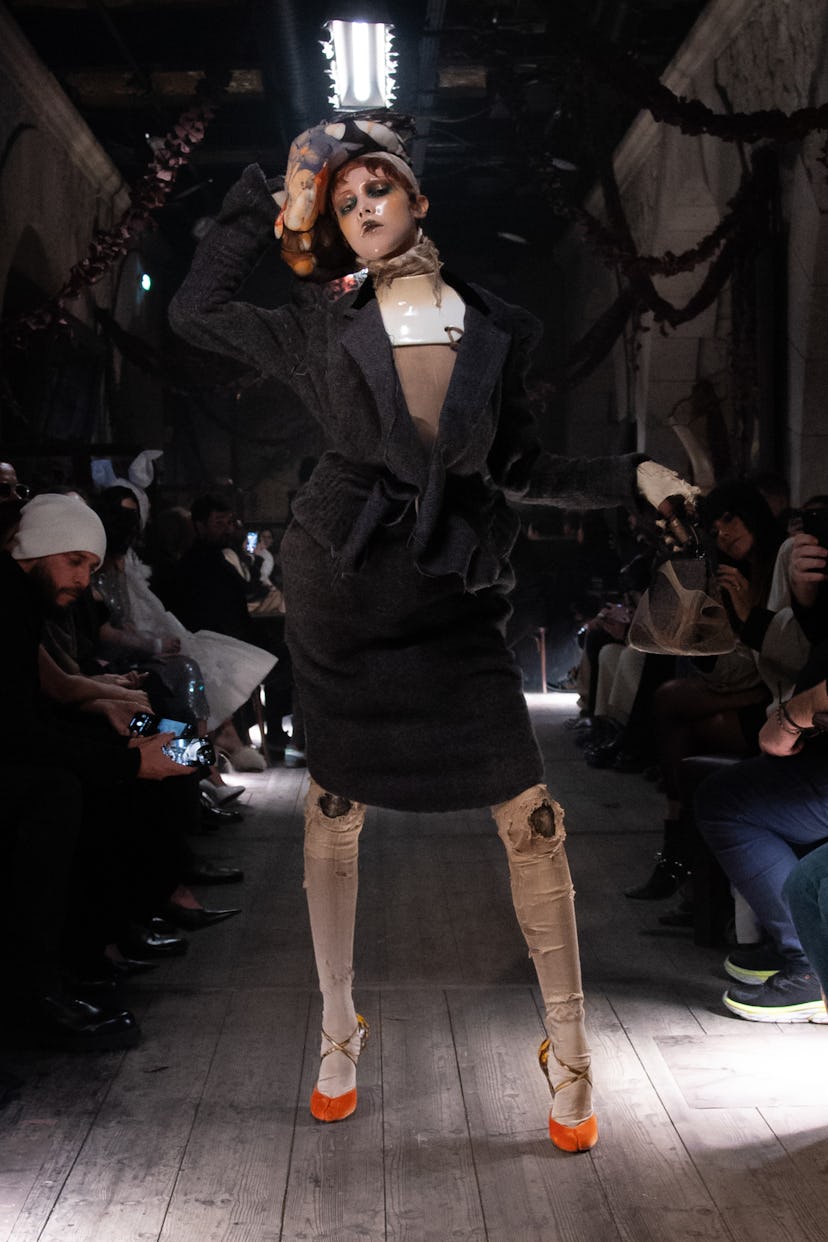Maison Margiela Closes Couture Week With a Transcendent Artisanal Collection

On a hazy, rainy evening during the last night of Paris Couture Week, Maison Margiela took guests under the Pont Alexandre III bridge for an emotional and idiosyncratic experience that only John Galliano could create. Think: theatrical fashion with a cast of characters as models, some extreme silhouettes, and a live musical performance and film. Maison Margiela’s Artisanal 2024 show may have been the most-talked about and anticipated show of the spring 2024 couture season; after all, it was the first time Margiela presented on the haute couture schedule since 2020, and the final runway of the season. And it delivered.
The event began with violet cocktails and matching hard candies inside a restaurant decorated like a Belle Epoque brasserie. A decay of festivities was strewn about: broken plates, half-full cups, paper streamers, empty crystal liquor bottles. Next came a set by Lucky Love and a gospel choir, then a film that transformed into the actual show. Fantasy merged with reality as house favorite model Leon Dame moved from the screens into the venue, then onto the runway, which snaked under the bridge and through the restaurant. The audible gasps and claps came instantaneously: it was an incredibly innovative and emotional way to kick off a show during a season that’s been dominated by the everyday.
It’s possible there has never been a Margiela collection that mixed the worlds of Galliano and Margiela so perfectly into one. All the Galliano-isms were there, like reshaping and modifying the body, but there were also plenty of deep Margiela codes, from the odes to deconstruction and decay to the face coverings and fetishism. Each model resembled a character and broke the fourth wall, staring the audience members in the face as they moved.
The collection kicked off with reinterpreted naked dresses bearing elements of art nouveau and Victorian eras—before quickly taking a turn into extreme shapes that hinted at body modifications and prosthetics: padding on the hips, butt, and beyond. Fabrics were tattered and gray, part-Dickens and part-surrealist fantasy. Next came translucent dresses in sheer washes of blurred, rainbow colors revealing corsets underneath, the models’ forms obscured by layers of intensely light fabric. To contrast all that, there was also dark suiting; separates were styled as if some of the models had been caught in a rainstorm. (While guests sipped cocktails before the show, the sound of rain played over speakers and lightning flashed indoors). One model carried a garbled umbrella. Buttoned-up, all-black looks came structured and stylized before a series of models resembling Little Bo Peep dolls ruled the runway. A vinyl corset dress modeled by none other than Gwendoline Christie.
Every bit of the show, from the music to the film and the theatrics on the runway—not to mention the actual clothing itself—was dramatic. But the collection was also a subtle commentary on the concept of beauty modifications and the lengths to which people will go to transform themselves. What does it mean to go from a naked dress to a tattered broken creature—and back again to a youthful, doll-like figure? (The show notes referred to these as “doll-like accents” and “coquettish expressions with illustrative shoulder lines.” These are all, to some extent, characters in the Galliano universe.) The fact that Kris Jenner, Kylie Jenner, and Kim Kardashian were the marquee celebs sitting front row was brilliantly ironic, given the context of the collection. Nadia Lee Cohen also dressed in a bunny hood and Tommy Cash was up to his usual antics, this time carrying a sky-high stack of designer boxes and shopping bags.
The technique was exceptional here: those heavy, tattered pieces were actually featherlight, constructed through milletrage—“a filtrage of a mille-feuille of organza and felt under a wool crêpe printed with a trompe l’oeil of the texture of a classic gentleman’s cloth,” according to the show notes. Galliano created the collection in 12 months, developing new techniques in his own language along the way. “Seamlace,” for example, refers to garments constructed entirely from encrusted fragments of lace, while “emotional cutting” is “a new form of cutting which imbues a garment with the unconscious gestures that shape our expressions.” Margiela’s spring 2024 Artisanal show didn’t just deliver on palpable emotion with a visceral reaction—it also sparked intrigue on a level beyond aesthetics.